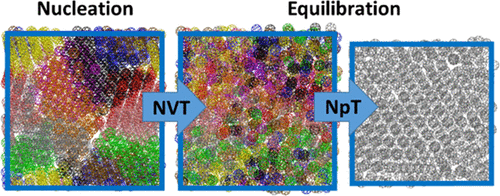The morphology of small-molecule organic semiconducting materials can vary from single crystals via polycrystalline films with varying grain sizes to amorphous structures, depending on the process conditions. This structural variety affects the electronic properties and, thus, the performance of organic electronic devices. A nucleation-equilibration approach is investigated, whose focus is on the construction of morphologies with controlled variations in the average grain size. Its computational requirements are low because nucleation is purely based on geometrical considerations, thus allowing the construction of model systems of experimentally relevant sizes. Its application is demonstrated for C60 and pentacene by generating single-component films that vary from amorphous to crystalline structures. It is further generalized to two-component films and applied to C60: Pentacene blends as well as dilute n-doped C60 structures. When combined with electronic structure calculations in the future, the nucleation-equilibration approach can offer insights into the impact of polycrystallinity on electronic and charge-transport properties in the absence of any knowledge about the growth mechanism and for a broad set of systems.

The morphology of small-molecule organic semiconducting materials can vary from single crystals via polycrystalline films with varying grain sizes to amorphous structures, depending on the process conditions. This structural variety affects the electronic properties and, thus, the performance of organic electronic devices. A nucleation-equilibration approach is investigated, whose focus is on the construction of morphologies with controlled variations in the average grain size. Its computational requirements are low because nucleation is purely based on geometrical considerations, thus allowing the construction of model systems of experimentally relevant sizes. Its application is demonstrated for C60 and pentacene by generating single-component films that vary from amorphous to crystalline structures. It is further generalized to two-component films and applied to C60: Pentacene blends as well as dilute n-doped C60 structures. When combined with electronic structure calculations in the future, the nucleation-equilibration approach can offer insights into the impact of polycrystallinity on electronic and charge-transport properties in the absence of any knowledge about the growth mechanism and for a broad set of systems.
